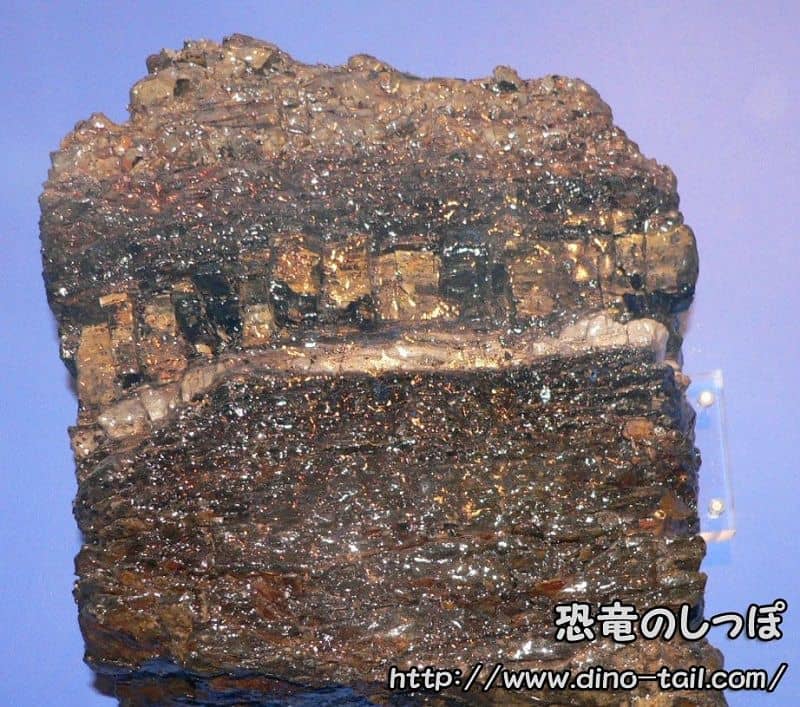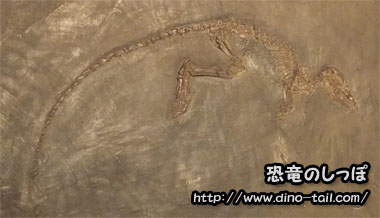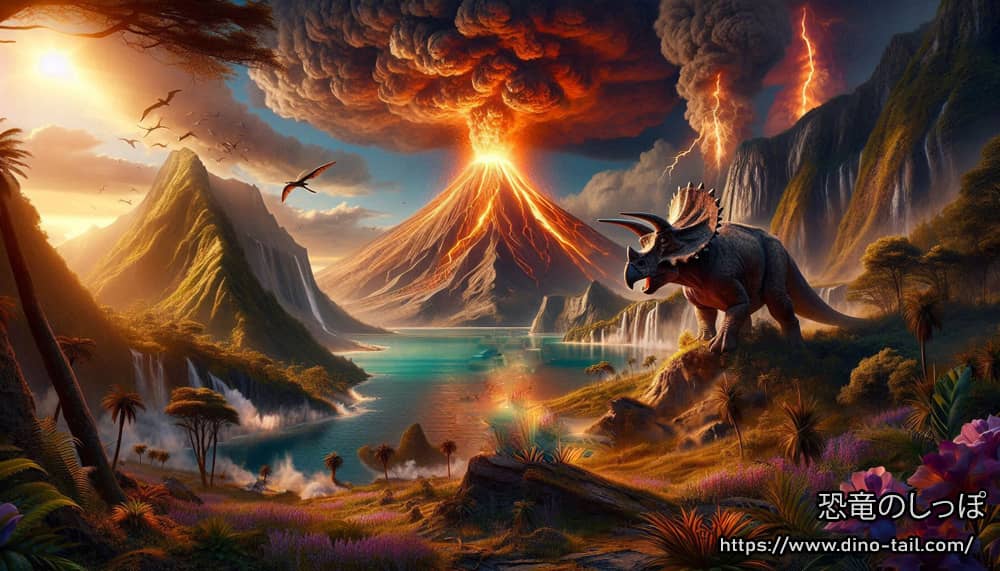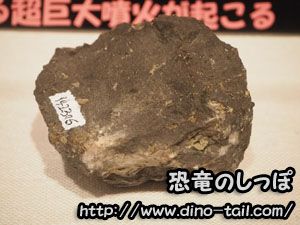The Meteorite Impact of 66 Million Years Ago
All non-avian dinosaurs went extinct at the end of the Cretaceous period (66 million years ago).
"What happened to the Earth 66 million years ago (*1)?" and "What triggered the demise of the dinosaurs?" are frequently discussed topics in the media, driven by our fascination with dinosaurs.
The leading candidate for the answer is a "meteorite impact."

At the boundary between the geological layers of the Mesozoic Cretaceous period, when dinosaurs went extinct, and the subsequent Cenozoic Paleogene period, there is a layer with an unusually high concentration of iridium. Iridium concentrations 20-160 times higher than in other layers have been observed.
Iridium is a substance rarely found in the Earth's crust but is abundant in meteorites. This layer is called the "K-Pg boundary" (formerly known as the "K-T boundary").
It was previously known that "a massive meteorite struck near Central America at the end of the Cretaceous period" based on the facts that "the K-Pg boundary contains special particles called shocked quartz, which are larger near Central America than in Europe or the Pacific" and "the K-Pg boundary around the Gulf of Mexico and the Caribbean Sea contains many tsunami deposits."
The "meteorite impact as the cause of dinosaur extinction" theory has been widely supported, but there have been various counterarguments, such as volcanic activity and temperature decline theories.
What decisively confirmed the "meteorite impact as the cause of dinosaur extinction" theory was the discovery in 1991 of a 180-kilometer-diameter crater off the coast of Mexico's Yucatán Peninsula.
Analysis of samples from this feature, called the Chicxulub crater, revealed that it was the site of the meteorite impact at the end of the Cretaceous and the cause of the K-Pg boundary.
Investigating this has made it easier to scientifically construct the scenario of the dinosaur extinction. Iridium anomalies have been observed at over 300 K-Pg boundary sites worldwide.
(*1) The boundary between the Cretaceous (Mesozoic) and Paleogene (Cenozoic) was formerly dated to "65.5 million years ago," but was changed to "66 million years ago" in the 2013 announcement by the International Commission on Stratigraphy. This roughly corresponds to the result of a precise measurement of the meteorite impact timing by planetary scientist Professor Paul Renne in 2015 - "about 66.04 million years ago (±30,000 years)."
The Dinosaur Extinction Scenario
The widely accepted scenario for the dinosaur extinction is as follows:
- A meteorite 10-15 kilometers in diameter that fell off the coast of the Yucatán Peninsula in Mexico kicked up a massive amount of dust.
-
The dust in the atmosphere blocked sunlight for about two years, preventing photosynthetic plants on land and near the sea surface (especially angiosperms, which require a lot of light) from growing.
Fossils show that fungi, which do not require light, and ferns, which can grow with little light, flourished during this period. - The inability of angiosperms to grow led to the extinction of herbivorous dinosaurs that relied on them as their primary food source.
-
The extinction of herbivorous dinosaurs led to the extinction of the carnivorous dinosaurs that preyed on them.
It is thought that large species, which required large amounts of food, disappeared first.

Powered by DALL-E3, 2024.
Furthermore, the rocks off the Yucatán Peninsula where the meteorite struck contained a lot of carbonate and sulfur.
It is known that the impact heated the sulfur in the rocks, causing it to evaporate and generate a large amount of sulfuric acid gas, which then fell as acid rain.
It has also been proposed that this strong acid rain could have been a direct cause of the extinction by destroying the food chain.
The blocking of sunlight caused the Earth's climate to cool by 10-28 degrees Celsius, and this rapid cooling would have also affected plants and animals.
The angiosperms that temporarily disappeared were able to be preserved as pollen and seeds, and they made a comeback after the Earth's environment stabilized.
The Conditions of the Meteorite Impact
Much has been learned from analyses about the conditions of what happened 66 million years ago in the Yucatán Peninsula, Mexico.
The meteorite, 10-15 kilometers in diameter, struck the Earth's surface at an angle of about 30 degrees. It is known that it collided in a north-northwesterly direction, causing dust to be thrown up mainly in the direction of North America.
The fact that the highest extinction rate of organisms was in North America is one of the grounds for thinking that the meteorite impact caused a mass extinction of organisms.
The impact velocity was 20 kilometers per second (which translates to a staggering 72,000 km/h. For comparison, the top speed of a bullet train is about 300 km/h).
The energy of the impact was about one billion times that of the atomic bomb dropped on Hiroshima. The temperature of the plume that rose from the impact reached 10,000 degrees Celsius, and the surface temperature of the Earth became 260 degrees Celsius. The hot dust that was kicked up would have rained down on forests in an ignited state, causing wildfires in various places.
The magnitude of the earthquake caused by the impact was over 11. Landslides occurred on the seabed, and tsunamis up to 300 meters high were generated. It is clear that this was a catastrophe of such a scale that it had a global impact.
According to a paper published in the British scientific journal Nature in 2022, the meteorite is estimated to have struck in the spring in the Northern Hemisphere (and autumn in the Southern Hemisphere).
Why Did Turtles and Crocodiles Survive?
The meteorite impact 66 million years ago, and the temporary die-off of photosynthetic plants it caused, led to the extinction of many organisms, including dinosaurs.
So, what is the reason "dinosaurs went extinct, while turtles, crocodiles, and small mammals survived"?
It is explained by
[habitat]
,
[dependence on photosynthetic plants]
, and
[body size]
.
In the mass extinction at the end of the Cretaceous, 90% of the organisms living on land disappeared, while only 10% of the organisms living in freshwater environments such as rivers and swamps went extinct.

Leptictidium
In addition to the food chain based on photosynthetic plants, freshwater environments such as rivers and swamps have a well-developed detritus food chain. This is an energy chain based on fallen leaves, decaying wood, animal carcasses, insects, and subterranean organisms.
For the organisms included in the detritus food chain, the "disappearance of fresh plants and animals" did not immediately cause catastrophic damage. This is evident from the fact that fungi and ferns showed an abnormal proliferation immediately after the meteorite impact. For them, the die-off of photosynthetic plants for a few years did not mean an immediate loss of their energy source.
Turtles and crocodiles belonged to this chain.
Some terrestrial organisms, such as small mammals (relatives of mice), also managed to survive. Their small body size contributed to their survival in the harsh environment. "Small body size" means "less food required" and "enables reproduction from a young age (faster generation turnover)." Also, as mentioned earlier, since the meteorite impact occurred in autumn in the Southern Hemisphere, mammals and reptiles that were preparing for hibernation in burrows may have been less affected. However, they were by no means unscathed. Some species of turtles, crocodiles, and mice went extinct, while some survived and were able to prosper thereafter.
Other Extinction Theories

Powered by DALL-E3, 2024.
While the "meteorite impact theory" is currently the most widely accepted, there are other theories that attempt to explain the mass extinction at the end of the Cretaceous.
The main ones are the "volcanic eruption theory" and the "gradual extinction theory."

Evidence of end-Cretaceous volcanic activity
The volcanic eruption theory posits that environmental destruction was caused by volcanic activity that continued at the end of the Cretaceous.
It is based on the fact that an abnormal concentration of iridium can also be confirmed by volcanic eruptions, and that evidence of volcanic activity called flood basalts, formed at the end of the Cretaceous, is found in the Deccan Traps of India. It seems that a lava flow occurred at about the same time as the meteorite impact - about 66.04 million years ago. Research results published in 2015 also suggest the possibility that the meteorite impact was the cause of the lava flow.
The gradual extinction theory is the theory that the dinosaurs as a species gradually declined in number, and that "the meteorite impact and the extinction of the dinosaurs are unrelated (or just delivered the final blow)."
The research group that advocates this theory bases it on the fact that they examined the numbers of 30 dinosaur species and found that their populations had decreased by the time of the K-Pg boundary. They explain that the number of species plummeted because a change in sea level narrowed the land suitable for dinosaur habitats, and they were unable to maintain a large enough population to withstand environmental changes such as volcanic activity.
Looking at the raw fossil data, the number of known genera in the Maastrichtian, the last age of the Cretaceous (about 72.1 to 66.0 million years ago), appears to be lower than in the preceding Campanian age (about 83.6 to 72.1 million years ago). This has been used as evidence for the gradual extinction theory, suggesting that dinosaurs were in decline before their final extinction.
However, when a statistical method called the ACE model was applied to both ages separately, the estimated true diversity was shown to be nearly stable between the Campanian (about 246 genera) and the Maastrichtian (about 246 genera). This strongly suggests that the apparent decrease in the number of known genera in the Maastrichtian is not a biological decline, but rather an artifact of "sampling bias" due to the fact that the sampling of Maastrichtian strata is less complete than that of the Campanian (the completeness of the Campanian record is 48%, while the Maastrichtian is 39%). In other words, the "gradual extinction theory" is being refuted.
Both the "volcanic eruption theory" and the "gradual extinction theory" are becoming less convincing due to insufficient evidence and contradictions. The analysis results from the Chicxulub crater off the coast of the Yucatán Peninsula in Mexico are giving the "meteorite impact theory" a firm standing.
